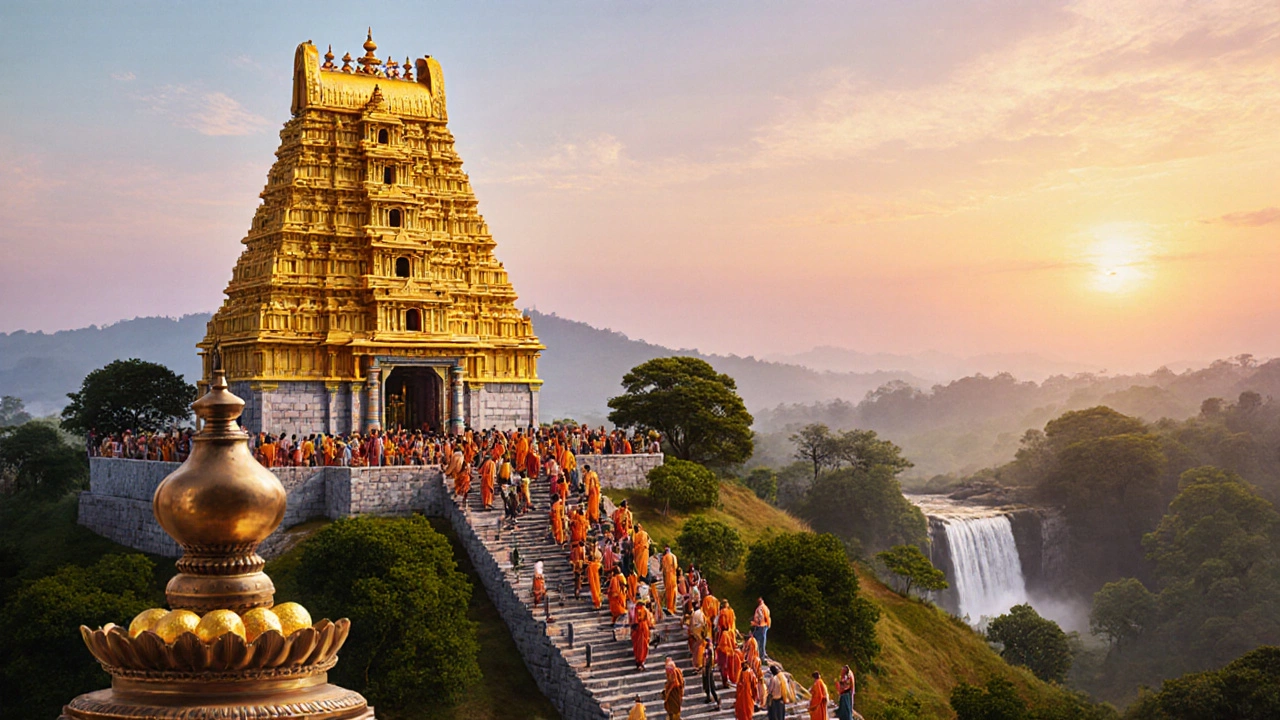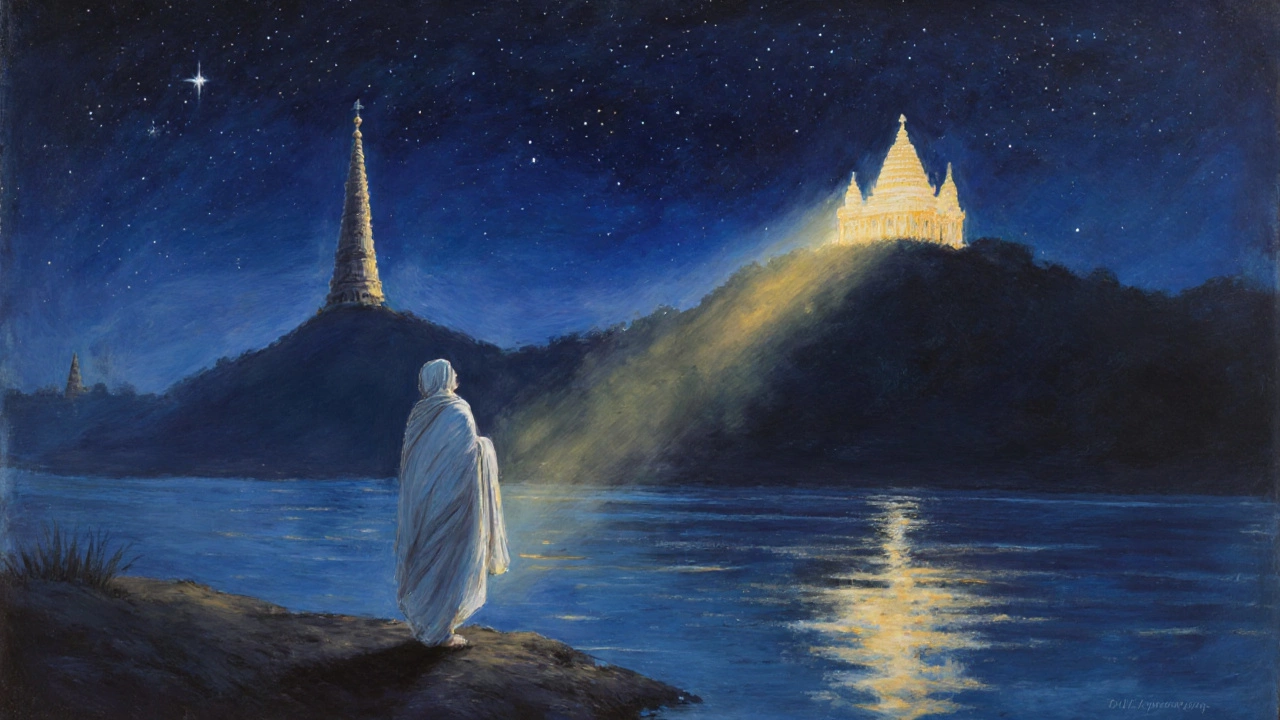Which Is the Holiest Temple in India? A Deep Dive into Sacred Sites

- Oct, 25 2025
- 0 Comments
- Aaron Blackwood
When you ask yourself which is the holiest temple in India, you’re not just looking for a building - you’re hunting for a place where legends, devotion, and history converge. India’s spiritual map is dotted with shrines that claim the top spot, each backed by millions of pilgrims, royal patronage, and centuries‑old myths. In this guide we’ll unpack the most frequently mentioned contenders, explain how “holiness” gets measured, and give you a clear answer based on pilgrimage volume, scriptural references, and cultural impact.
How Do We Define “Holiness”?
Before naming a single temple, it helps to set the criteria that scholars, devotees, and tourism boards use to rank sacred sites. The most common metrics are:
- Scriptural endorsement - mentions in major texts like the Vedas, Puranas, or the Bhagavad Gita.
- Pilgrim footfall - annual visitors, especially those undertaking traditional vows or “parikrama” journeys.
- Historical patronage - support from dynasties, saints, or national leaders that amplify the shrine’s prestige.
- Ritual uniqueness - special ceremonies or miracles that can’t be found elsewhere.
- Geographic symbolism - locations that represent cardinal directions or cosmic points in Hindu cosmology.
With these lenses, we can objectively compare the top candidates.
The Front‑Runner: Tirumala Venkateswara Temple
Tirumala Venkateswara Temple is a hill‑top shrine in Andhra Pradesh dedicated to Lord Venkateswara, an incarnation of Vishnu. Founded in the 9th century, it now welcomes over 50 million devotees each year, making it the world’s busiest pilgrimage site. Its fame stems from the legend of a devotee‑king who rescued the deity from a demon, and from the practice of offering “prasadam” in the form of gold‑coated laddu. The temple’s strict rituals, overseen by a hereditary priesthood, add layers of sanctity that few other sites can match.
Key highlights that reinforce its claim to ultimate holiness:
- Direct mention in the Varaha Purana and Skanda Purana.
- Annual “Brahmotsavam” festival draws over 2 million participants.
- Home to the “Mookambika” sacred forest, considered a living embodiment of the divine.
The Eternal North: Kashi Vishwanath Temple
Kashi Vishwanath Temple sits on the ghats of Varanasi, Uttar Pradesh, honoring Shiva as the Lord of the Universe. Its origins trace back to the 11th century, but the site is believed to have been a seat of worship since the time of the Vedas. Varanasi itself is called “the city of light” and is said to be the place where a soul can achieve moksha simply by stepping onto its soil.
The temple’s holiness is amplified by several unique factors:
- Counts 30 million annual visitors, most of whom perform the “Ganga Aarti” at sunrise.
- Featured in numerous Puranic stories, especially the tale of Shiva granting the boon of the “Kalpavriksha” to devotees.
- Holds the famous “Kashi Ka Dham” status, making it a cornerstone of Shaivite pilgrimage circuits.
Other Contenders Worth Mentioning
While Tirumala and Kashi dominate the conversation, India’s tapestry of sacred architecture offers several other sites that stake a claim on the title of “holiest” based on regional devotion or specific deity worship.
| Temple | Location | Primary Deity | Annual Pilgrims (approx.) | Unique Holy Feature |
|---|---|---|---|---|
| Tirumala Venkateswara Temple | Andhra Pradesh | Venkateswara (Vishnu) | 50 million+ | Gold‑coated laddu prasadam |
| Kashi Vishwanath Temple | Uttar Pradesh | Shiva | 30 million+ | Located on the sacred Ganges banks |
| Jagannath Temple, Puri | Odisha | Jagannath (Krishna) | 10 million+ (including Ratha Yatra) | Ratha Yatra chariot festival |
| Shirdi Sai Baba Temple | Maharashtra | Sai Baba (Agnostic Saint) | 15 million+ | Guru‑type devotion transcending sects |
| Meenakshi Amman Temple | Tamil Nadu | Meenakshi (Parvati) & Sundareswarar (Shiva) | 6 million+ | Distinct Dravidian gopurams |
Each of these temples shines for different reasons: Jagannath’s chariot festival draws a massive crowd, Shirdi’s universal appeal cuts across religious lines, and Meenakshi’s architectural splendor mesmerizes tourists and worshippers alike.

What Pilgrims Really Feel: The Emotional Metric
Numbers and scriptures can tell a story, but the personal experiences of devotees provide the final verdict. Interviews with long‑term pilgrims reveal common threads:
- At Tirumala, the act of offering money at the “Laddu” shrine feels like a direct transaction with the divine.
- In Varanasi, standing on the ghats at sunrise while chanting mantras creates a sensation of timelessness that many claim can’t be replicated elsewhere.
- Jagannath’s “Ratha Yatra” evokes a carnival of devotion, where the deity’s journey feels personal to every participant.
These emotional benchmarks often tip the scales for travelers choosing which site to prioritize.
Practical Tips for Visiting the Top Holy Sites
If you decide to embark on a pilgrimage, here are a few hacks to make the journey smoother:
- Plan ahead for Tirumala. Secure an “e‑darshan” ticket online to avoid days‑long queues. Early morning darshan (5 am) offers a quieter experience.
- Dress modestly in Varanasi. Both men and women should cover shoulders and knees. Portable water bottles are a must during summer heat.
- Use local guides for Jagannath. They can navigate the bustling “Sannidi” (inner sanctum) and explain the symbolism of each chariot wheel.
- Respect local customs. Photography is prohibited inside most inner sanctums; always ask before snapping.
- Carry a small amount of cash. Many offerings are still made in cash, and on‑site stalls accept only Indian rupees.
Following these pointers helps you focus on the spiritual side rather than logistical hassles.
Conclusion: The Verdict on Holiness
Putting together scriptural backing, pilgrim volume, historic patronage, and lived experience, the consensus among scholars and devotees leans heavily toward Tirumala Venkateswara Temple as the holiest temple in India. Its unparalleled blend of mythology, millions‑strong devotion, and unique rituals create a spiritual gravity that surpasses even the ancient allure of Kashi Vishwanath.
That said, true holiness is deeply personal. If you feel a pull toward Shiva’s fire on the banks of the Ganges, Kashi might be your ultimate destination. The best approach is to experience multiple sites and let your heart decide which resonates most.
Which temple receives the most visitors each year?
Tirumala Venkateswara Temple in Andhra Pradesh records over 50 million pilgrim visits annually, making it the busiest sacred site worldwide.

Can non‑Hindus enter Kashi Vishwanath Temple?
Yes, Kashi Vishwanath welcomes visitors of all faiths, though only Hindus may perform the inner‑sanctum rituals. Non‑devotees can admire the architecture and join the Ganga Aarti.
What is the significance of the Laddu at Tirumala?
The Laddu, made from gram flour, ghee, and sugar, is considered a direct blessing from Lord Venkateswara. Offering and receiving it is believed to grant prosperity and spiritual merit.
When is the best time to visit Jagannath Temple?
The Ratha Yatra festival in June or July is the most vibrant, but for a quieter experience, the months of October-December offer cooler weather and shorter queues.
Are there any restrictions on photography inside the temples?
Most inner sanctums prohibit cameras to preserve sanctity. Visitors can photograph the exterior, courtyards, and surrounding areas, but always check signage before shooting.